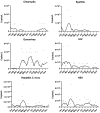Monitoring Multiple Sexually Transmitted Pathogens Through Wastewater Surveillance
- PMID: 40559570
- PMCID: PMC12195674
- DOI: 10.3390/pathogens14060562
Monitoring Multiple Sexually Transmitted Pathogens Through Wastewater Surveillance
Abstract
Wastewater-based epidemiology (WBE) offers a promising tool for sexually transmitted infection (STI) surveillance, especially in settings where underdiagnosis or social stigma complicates conventional reporting. To assess its utility, we conducted a year-long study examining six STIs, Chlamydia trachomatis, Treponema pallidum, Neisseria gonorrhoeae, human immunodeficiency virus (HIV), hepatitis C virus (HCV), and herpes simplex virus (HSV), in weekly composite samples from the primary influent of a small-sized Midwestern wastewater treatment plant. Pathogen detection and quantification were performed via digital PCR. Among the tested targets, Gonorrhea, HIV, HCV, and HSV were detected at the highest frequencies, often in 40-50% of the samples, while Chlamydia and Syphilis appeared less frequently. Despite the variability in detection patterns, this study demonstrates that even infrequent signals can reveal community-level shedding of poorly reported or asymptomatic infections. Although month-to-month wastewater data were not strongly correlated with corresponding clinical records, which could potentially reflect delayed healthcare seeking and pathogen-specific shedding dynamics, the overall findings underscore WBE's ability to complement existing surveillance by capturing infections outside traditional healthcare channels. These results not only advance our understanding of STI prevalence and population shedding but also highlight the practical benefits of WBE as an early warning and targeted intervention tool.
Keywords: HIV; STD/STI; chlamydia; gonorrhea; hepatitis C virus; herpes; syphilis; wastewater-based epidemiology.
Conflict of interest statement
The authors declare no conflicts of interest.
Figures



Similar articles
-
Population-based biomedical sexually transmitted infection control interventions for reducing HIV infection.Cochrane Database Syst Rev. 2011 Mar 16;(3):CD001220. doi: 10.1002/14651858.CD001220.pub3. Cochrane Database Syst Rev. 2011. PMID: 21412869
-
Population-based interventions for reducing sexually transmitted infections, including HIV infection.Cochrane Database Syst Rev. 2004;(2):CD001220. doi: 10.1002/14651858.CD001220.pub2. Cochrane Database Syst Rev. 2004. Update in: Cochrane Database Syst Rev. 2011 Mar 16;(3):CD001220. doi: 10.1002/14651858.CD001220.pub3. PMID: 15106156 Updated.
-
Population-based interventions for reducing sexually transmitted infections, including HIV infection.Cochrane Database Syst Rev. 2001;(2):CD001220. doi: 10.1002/14651858.CD001220. Cochrane Database Syst Rev. 2001. Update in: Cochrane Database Syst Rev. 2004;(2):CD001220. doi: 10.1002/14651858.CD001220.pub2. PMID: 11405980 Updated.
-
Behavioral interventions to reduce risk for sexual transmission of HIV among men who have sex with men.Cochrane Database Syst Rev. 2008 Jul 16;(3):CD001230. doi: 10.1002/14651858.CD001230.pub2. Cochrane Database Syst Rev. 2008. PMID: 18646068
-
Enhanced Surveillance of Sexually Transmitted Infections to Foster a Learning Public Health System.JAMA Netw Open. 2025 Jun 2;8(6):e2514308. doi: 10.1001/jamanetworkopen.2025.14308. JAMA Netw Open. 2025. PMID: 40526386 Free PMC article.
Cited by
-
Wastewater Surveillance for Group A Streptococcus pyogenes in a Small City.Pathogens. 2025 Jul 3;14(7):658. doi: 10.3390/pathogens14070658. Pathogens. 2025. PMID: 40732705 Free PMC article.
References
-
- World Health Organization Sexually transmitted infections (STIs) [Internet]. Geneva: World Health Organization; 2025 May 29. [(accessed on 29 May 2025)]. Available online: https://www.who.int/news-room/fact-sheets/detail/sexually-transmitted-in...
-
- Centers for Disease Control and Prevention Sexually Transmitted Infections Surveillance 2022 [Internet]. Atlanta (GA): CDC; 2022. [(accessed on 29 May 2025)]; Available online: https://www.cdc.gov/sti-statistics/media/pdfs/2024/11/2022-STI-Surveilla....
-
- Balfe M., Brugha R., O’Connell E., McGee H., O’Donovan D., Vaughan D. Why don’t young women go for Chlamydia testing? A qualitative study employing Goffman’s stigma framework. Heal. Risk Soc. 2010;12:131–148. doi: 10.1080/13698571003632437. - DOI
MeSH terms
Substances
LinkOut - more resources
Full Text Sources
Medical
Research Materials

